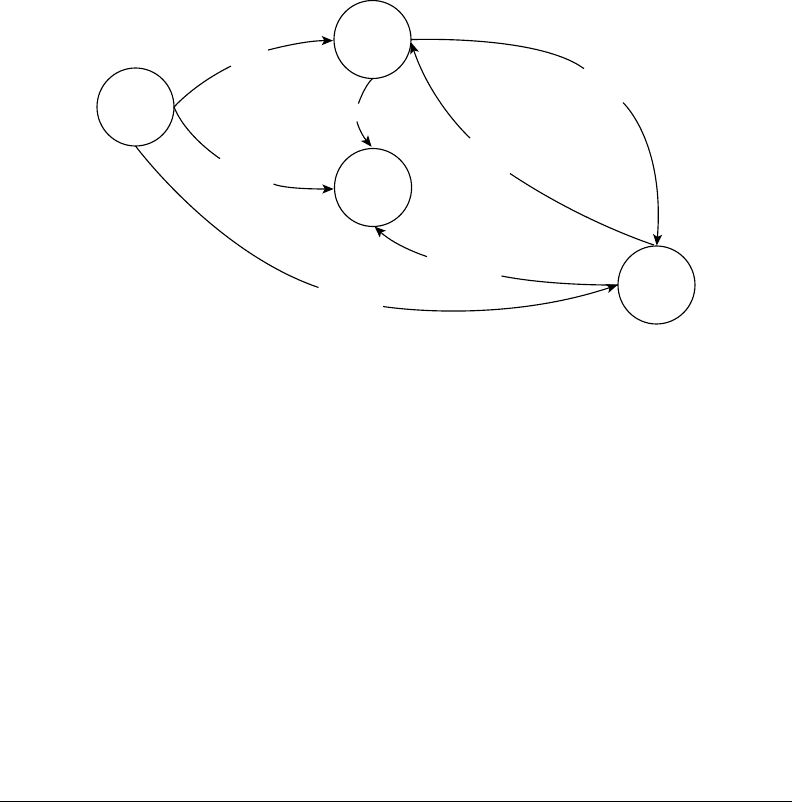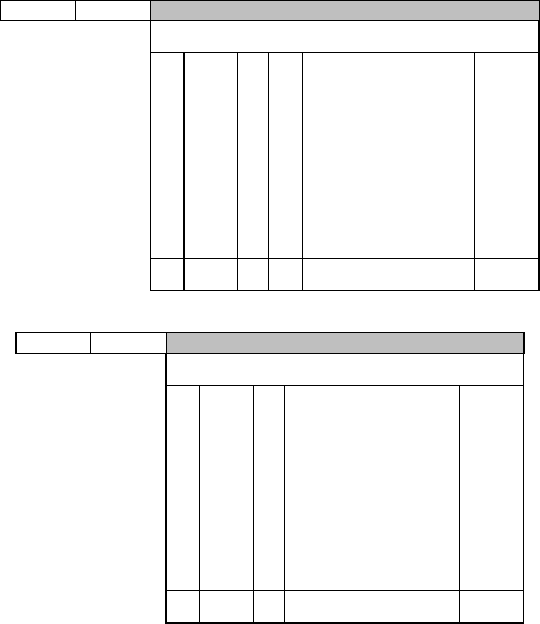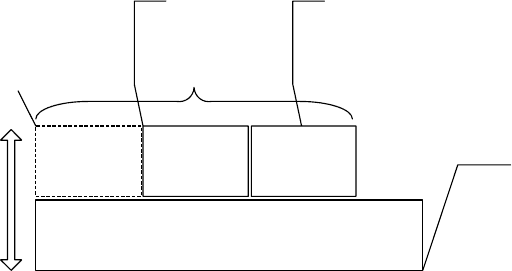Wilamowski B.M., Irwin J.D. The Industrial Electronics Handbook. Second Edition: Industrial Communication Systems
Подождите немного. Документ загружается.


47-10 Industrial Communication Systems
the.earliest-deadline-rst.scheduling.mechanism.[13]..Second,.static.scheduling.eases.synchronization.
between.safety.chips.mandatory.for.the.close.cooperation.between.the.safety.chips..Both.chips.start.at.
the.same.time.with.the.execution.of.function.in.the.same.order.
e
.state.machine.controls.the.behavior.of.the.node..According.to.inputs.received,.it.decides.to.
which.state.to.switch.to..In.a.SafetyLon.node.four.states.are.specied.as.illustrated.in.Figure.47.8..
Aer.a.reset.the.node.is.in.POWER.UP.state.and.runs.through.the.start-up.procedure..For.example,.
the.hardware.is.tested,.the.hardware.interfaces.are.initialized.and.conguration.parameters.are.
copied.from.the.ash.memory.to.the.RAM.due.to.performance.reasons..In.case.of.no.error,.the.
node.enters.the.RUN.state.where.the.node.is.operating..If.safety-critical.failures.are.detected,.the.node.
switches.to.FAIL.SAFE.state..In.this.state,.the.functionality.of.the.node.is.limited.to.a.minimum.
that.does.not.jeopardize.safety..e.fail.safe.state.is.only.le.when.the.critical.fault.was.eliminated.
by.an.operator..MODIFY.state.is.used.to.congure.the.node.(e.g.,.to.make.a.safe.binding)..In.this.
state,.the.node.provides.only.such.functionality.necessary.to.execute.conguration.requests.and.
send.the.responses.
47.6 the SafetyLon tools
SafetyLon.provides.two.types.of.tools:.a.development.tool.called.application.builder.that.gives.the.user.
the.possibility.to.congure.the.user-application.(e.g.,.specifying.the.safe.and.non-safe.network.variable.
types)..Moreover,.a.SafetyLon.management.tool.makes.the.safety-related.commissioning,.conguration.
of.the.rmware.and.user-application,.maintenance.of.the.safety-related.application,.and.decommission-
ing
.of.nodes.or.removal.of.bindings.possible.
e
.development.tool.is.a.non-safe.tool.that.gets.a.script.le.as.input.(see.Figure.47.9).which.among.
LonWorks.specic.parameters.includes
•
. e.type.of.EN.14908.controller
•
. e.name.and.type.of.non-safe.network.variables.and.the.name.and.type.of.safe.network.variables
Additionally,
.the.application.builder.interfaces.with.the.LonMark.device.resource.API.where.the.
format.and.size.of.the.network.variables.is.taken.from.
The
.output.of.the.application.builder.are.plain.text.c-.and.header-files.containing.all.informa-
tion
.required.to.run.the.user-application.as.intended.(e.g.,.a.file.with.the.network.variable.table.
that.holds.the.SafetyLon.message.as.well.as.the.safety-related.payload.of.the.message)..The.files.are.
Run
No failure
Safety critical failure
Safety critical
failure
Safety critical
failure
Modify
Start safety-related
conguration
Stop safe-related
conguration
Safety-related conguration
Fail safe
Power up
FIGURE 47.8 Node.state.machine.
© 2011 by Taylor and Francis Group, LLC

SafetyLon 47-11
linked.to.the.user-application.and.the.safety-related.firmware..Since.a.non-safe.tool.is.used,.it.is.
not.allowed.to.upload.all.the.user-application.remotely.as.safety.integrity.cannot.be.ensured.with.
a.high.probability.
e
.SafetyLon.management.tool.is.divided.into.a.SafetyLon.application.(SLA).interfacing.with.the.
local.network.service.(LNS).platform.[14]..Additionally,.a.SafetyLon.library.(SLL).is.used.to.store.all.
SafetyLon.specic.data.and.provide.SafetyLon.functionality.as.shown.in.Figure.47.10.
SLA
.provides.services.to.congure.one.or.several. safe.nodes,. depending.on.the.network.system.
design..e.application.includes.an.interface.to.the.SLL.and.it.is.instantiating.the.SLL.within.the.ini-
tialization
.process..With.functions.used.from.this.library,.the.application.congures.the.safe.nodes..
e.user-interface.shows.the.operator.the.resources.of.every.safe.node.that.are.changeable..To.obtain.
information.from.devices,.the.application.uses.the.interface.to.the.LNS.Object.Server.API..It.is.required.
because.the.SLA.is.a.standard.LNS.plug-in.
e
.SLA.instantiates.the.LNS.Object.Server.and.then.it.is.passed.through.to.the.SLL.together.with.
at.least.LNS.network.and.system.object.during.initialization..As.a.consequence,.both.soware.parts.
interact.with.the.same.instance.of.LNS.Object.Server..e.event-sink.for.handling.LNS.events.is.imple-
mented
.in.the.SLA..us,.the.changes.in.the.LNS.Object.Server.event.handling.should.not.inuence.the.
functionality.of.the.SLL.
Input source file(s)
SafetyLon application builder
Output source files for
SafetyLon user-application
Safety-related
firmware
Safety-related binary
for SafetyLon node
LonMark device
resource API
FIGURE 47.9 Application.builder.
SafetyLon
application
SafetyLon library
SafetyLon
application
SafetyLon
application
LON
FIGURE 47.10 Structure.of.SafetyLon.management.tool.
© 2011 by Taylor and Francis Group, LLC

47-12 Industrial Communication Systems
e.SLL.soware.architecture.consists.of.two.interfaces.and.one.application..An.API.handles.the.con-
nection
.to.LNS.Object.Server,.another.API.is.the.interface.for.the.SLA.to.the.SLL..e.handling.of.LNS.
Object.Server.is.described.in.the.Echelon.guidelines.of.the.LNS.application.developer’s.kit.[15].
From
.the.implementation.point.of.view,.the.SLL.is.divided.into.three.parts..e.SLL.is.used.by.the.client..
It.provides.functions.to.congure.a.safe.node..It.uses.the.SafetyLon.message.part.to.build.and.check.the.
management.messages..e.message.is.sent.by.the.SLL.to.the.safe.node..e.current.conguration.of.a.
safe.node.including.the.safe.address.is.stored.in.the.SafetyLon.database..It.manages.and.stores.the.safe.
addresses..Additionally,.it.saves.all.conguration.information.
e
.SafetyLon.management.tool.supports.the.three-step.process.explained.in.Section.47.3.applied.to.
congure.and.commission.a.node..It.uses.explicit.messages.and.a.dened.message.structure.(cf..Figure.
47.11).dierent.from.the.one.used.to.exchange.sensor.or.actuator.data.among.nodes..erefore,.it.can.
be.explicitly.distinguished.between.a.message.sent.from.a.management.unit.and.messages.sent.from.a.
SafetyLon.node,.respectively.
e
. management.message. is. embedded. into. the. payload. of.an. explicit. message.. It. starts. with. a.
Command.ID.specifying.the.command.to.be.carried.out.at.node.side.(e.g.,.assign.a.safe.address.to.a.
network.variable)..e.destination.safe.address.(SADR).is.a.unique.safe.address.of.the.node.that.shall.be.
addressed..e.transaction.ID.is.a.consecutive.number.that.makes.a.correlation.of.request.and.response.
possible..Data.are.a.conguration.parameter.such.as.a.safe.address.of.a.network.variable..CRC16,.nally,.
is.a.2.byte.CRC.appended.to.the.message.to.ensure.data.integrity..In.case.of.a.response.message,.an.addi-
tional
.byte.is.included:.an.error.byte.that.is.set.by.the.node.(e.g.,.the.network.variable.is.not.available).
Tool related data
1 1
11 Code
Command ID
Source safe address
Transaction ID
Error code
Safety-related parameter
CRC
1 2Max. 343
Byte
(a)
Tool related data
1 1
11 Code
Command ID
Destination safe address
Transaction ID
Safety-related parameter
CRC
2Max. 35
(b)
3
Byte
FIGURE 47.11 (a). Request. message. of. SafetyLon. management. tool.. (b). Response. message. of. SafetyLon.
management.tool.
© 2011 by Taylor and Francis Group, LLC
SafetyLon 47-13
acronyms
1oo2. One.out.of.two
COTS
. Com
mercial
.o.th
e
.sh
elf
CRC
. Cyc
lic
.re
dundancy
.ch
eck
LNS
. Loc
al
.ne
twork
.se
rvice
LON
. Loc
al
.op
erating
.ne
twork
LSWord
. Lea
s
.sig
nicant
.wo
rd
MSWord
. Mos
t
.sig
nicant
.wo
rd
SADR
. Saf
e
.ad
dress
SFF
. Saf
e
.fa
ilure
.fr
action
SIL
. Saf
ety
.in
tegrity
.le
vel
SLA
. Saf
etyLon
.ap
plication
SLL
. Saf
etyLon
.li
brary
DU
. Dan
gerous
.un
detected
DD
. Dan
gerous
.de
tected
SD
. Saf
e
.de
tected
SU
. Saf
e
.un
detected
references
. 1.. International.Electrotechnical.Commission..IEC.61508—Functional.safety.of.electric/electronic/
programmable
.ele
ctronic
.sa
fety-related
.syst
ems.
.IEC,.Gen
eva,
.Sw
itzerland,
.1998.
. 2.. Euro
pean
. Nor
m.
. EN. 14908—Open. dat
a
. communic
ation
. in. buildin
g
. aut
omation,
. cont
rols
. and.
buildin
g
.ma
nagement—control
.net
work
.pr
otocol.
.CEN,.2005.
. 3.. T..Nova
k,
.P..Fisc
her,
.M..Holz,.M..Kiev
iet,
.and.T..Tam
andl.
.Safe.commis
sioning
.and.main
tenance
.
pro
cess
.for.a.saf
e
.system..In.Pro
ceedings of the Seventh IEEE International Workshop on Factory
Communication Systems,
.Dres
den,
.Ger
many,
.pp
.
.225–232,.2008.
. 4.. Ins
titute
.of.Elec
trical
.and.Elec
tronics
.Engin
eers
.Com
puter
.Societ
y.
.IEEE.Sta
ndard
.for.So
ware
.
Safet
y
.Pl
ans.
.IEEE.St
d.
.1228,.1994.
. 5.. C..Hat
ton.
.Saf
er C—Developing Soware for High-Integrity and Safety-Critical Systems.
.McGra
w-Hill
.
Boo
k
.Co
mpany
.Eur
ope,
.Ber
kshire,
.U.K.,.1995.
. 6.. T.. Nov
ak
. and. T.. Tam
andl.
. Arc
hitecture
. of. a. saf
e
. nod
e
. for. a. el
dbus
. sys
tem.
. In. Pro
ceedings
of the Fih IEEE International Conference on Industrial Informatics,
. Vol
.
. 1,. Vie
nna,
. Aus
tria,
.
pp.
101–106,
.200
7.
. 7.. Int
ernational
.Elec
trotechnical
.Commi
ssion.
.IEC.61508—Func
tional
.saf
ety
.of.elec
tric/electronic/
programmable
.ele
ctronic
.saf
ety-related
.sys
tems—Part
.2:.Req
uirements
.for.ele
ctrical/electronic/pro-
grammable
.ele
ctronic
.saf
ety-related
.sys
tems.
.IEC
,
.Gen
eva,
.Swi
tzerland,
.200
0.
. 8.. T..Tam
andl
.and.P..Preinin
ger.
.Online.self.tests.for.microco
ntrollers
.in.saf
ety
.rel
ated
.system
s.
.In.
Pro
ceedings of the Fih IEEE International Conference on Industrial Informatics,
.Vol
.
.1,.Vienna,.
Austria,.pp..137–142,.2007.
. 9.. P..Wrat
il
.and.M..Kiev
iet.
.Sic
herheitstechnik für Komponenten und Systeme.
.Hüt
hig
.Verl
ag,
.Heidel
berg,
.
Germ
any,
.p..203,.2007.
. 10.. H..Höl
scher
.and.J..Rader..Micr
ocomputers in Safety Technique, an Aid to Orientation for Developer
and Manufacturer.
.TÜV.Rh
einland,
.Co
logne,
.Ger
many,
.p..50,.1986,.Ch
apter
.7.
. 11.. H..Höl
scher,
.J..Rader..Micr
ocomputers in Safety Technique, an Aid to Orientation for Developer and
Manufacturer.
.TÜV.Rh
einland,
.Co
logne,
.Ger
many,
.p..86,.1986,.Ch
apter
.7.
. 12.. T..Nova
k
.and.B..Sev
cik.
.Netw
ork
.time.sync
hronization
.in.a.saf
e
.aut
omation
.netw
ork.
.In.Pro
ceedings
of the Seventh IEEE International Workshop on Factory Communication Systems,
.Dresden,.Germany,.
pp..305–313,.2008.
© 2011 by Taylor and Francis Group, LLC
47-14 Industrial Communication Systems
. 13.. W..Wolf..Computers as Components, Principles of Embedded Computing System Design..Morgan.
Kauf
man
.Pub
lishers,
.San.Fra
ncisco,
.CA,.pp
.
.377,.2001.
. 14.. P..Fisc
her,
.M..Holz,.and.M..Mentze
l.
.Netw
ork
.man
agement
.for.a.saf
e
.communic
ation
.in.an.unsa
fe
.
envir
onment.
.In.Pro
ceedings of the Fih IEEE International Conference on Industrial Informatics,
.
Vol
.
.1,.Vienn
a,
.Au
stria,
.pp
.
.131–136,.2007.
. 15.. Ech
elon
.Co
rporation,
.LNS.pr
ogrammer’s
.guide,.Turb
o
.edi
tion,
.Ec
helon,
.San.Jos
e,
.CA,.2004.
© 2011 by Taylor and Francis Group, LLC

48-1
48.1 Introduction
Many.industrial.automation.applications.are.designed.to.be.very.exible.in.order.to.manufacture.prod-
ucts
.with.incr
eased
.eci
ency.
.us,.a.exi
ble
.comm
unication
.infr
astructure
.is.requ
ired,
.lead
ing
.to.a.
grow
ing
.dema
nd
.for.wire
less
.net
works.
.Wirel
ess
.netw
orks
.ful
ll
.thes
e
.requ
irements
.beca
use
.the
y
.oer.
more.exi
bility,
.cost.redu
ctions,
.and.high
er
.mobi
lity
.to.the.autom
ation
.syst
em
.as.comp
ared
.to.thei
r
.
wire
d
.cou
nterparts.
Since
.comm
unication
.in.futu
re
.indu
strial
.auto
mation
.syste
ms
.will.most.like
ly
.be.real
ized
.by.real
-time
.
Ether
net
.proto
cols
.like.PROF
INET
.[IEC
06a,IEC06b],
.Ether
net/IP
.[Eth0
9],
.etc..(cf..Chapt
er
.37.of.this.
book
),
.the.corr
esponding
.wire
less
.tech
nology
.at.the.eld.leve
l
.has.to.be.suit
able
.and.care
fully
.cho-
s
en
.with.respe
ct
.to.the.appl
ication
.requ
irements,
.in.term
s
.of.both.depe
ndable
.and.temp
oral
.beha
vior.
.
ere
fore,
.IEEE.802.
11
.[IEE
07]
.wire
less
.loca
l
.area.netw
orks
.(WLA
Ns)
.are.an.inte
resting
.opti
on
.beca
use
.
they.were.init
ially
.desig
ned
.to.be.the.wire
less
.exte
nsion
.of.Ethe
rnet
.[IEE
05].
.Some.inte
resting
.appl
ication
.
scen
arios
.are.over
head
.mono
rail
.syste
ms
.or.auto
mated
.guid
ed
.vehi
cles
.(AGV
s)
.that.can.be.foun
d
.in.the.
area.of.logi
stics.
.For.inst
ance,
.AGVs.are.mobi
le
.trans
port
.syste
ms
.that.can.opera
te
.auto
nomously.
.ey.
carr
y
.load
s
.and.use.eith
er
.fork.lis.or.a.conv
eyor
.syste
m
.to.move.the.obje
cts
.to.be.trans
ported.
.Basi
cally,
.
they.are.used.to.deli
ver
.work.piec
es
.to.spec
ic
.manu
facturing
.proc
esses
.and.have.to.be.quit
e
.exi
ble
.by.
den
ition.
.In.a.typi
cal
.scen
ario,
.the.mobi
le
.syste
m
.cons
ists
.of.a.loca
l
.prog
rammable
.logi
c
.cont
roller
.(PLC
)
.
to.cont
rol
.the.vehi
cle.
.e.loca
l
.PLC.also.comm
unicates
.with.the.cent
ral
.cont
roller
.that.is.respo
nsible
.for.
overa
ll
.coor
dination
.and.task.assig
nment.
.e.task
s
.are.then.inde
pendently
.exec
uted
.by.the.auto
nomous
.
syste
ms.
.e.requ
irements
.are.dete
rmined
.by.the.velo
city
.and.the.numb
er
.of.vehi
cles
.in.the.enti
re
.syste
m.
48
Wireless Local
Area Networks
48.1. Introduction.....................................................................................48-1
48.2
. e.802
.11
.Fam
ily............................................................................48-2
48.3
. Physi
cal
.Lay
er...................................................................................48-2
Frequency.Bands. •. Modulation.Techniques
48.4. Medium.Access.Control.................................................................48-3
Distributed.Coordination.Function. •. Point.Coordination.Function
Enhanced.Distributed.Channel.Access. •. HCF.Controlled.
ChannelAccess. •. Direct.Link.Protocol.and.Block.ACK
48.5. Limitations.of.DCF.and.HCF.for.QoS.Support.
inInd
ustrial
.Env
ironments...........................................................48-8
48.6
. Secu
rity
.Mec
hanisms......................................................................48-9
48.7
. Fast.Han
dover..................................................................................48-9
Mechanisms.on.the.AP.Side. •. Mechanisms.on.the.Client.Side
48.8. Future.Enhancements...................................................................48-11
References...................................................................................................48-11
Henning Trsek
Ostwestfalen-
Lippe
Uni
versity
of
Appl
ied
Sci
ences
Juergen Jasperneite
Ostwestfalen-
Lippe
Uni
versity
of
Appl
ied
Sci
ences
Lucia Lo Bello
University of Catania
Milos Manic
University of Idaho
Idah
o
Fal
ls
© 2011 by Taylor and Francis Group, LLC

48-2 Industrial Communication Systems
48.2 the 802.11 Family
e.rst.wireless.standard.of.the.IEEE.802.family.was.the.802.11.one,.approved.by.the.IEEE.in.1997,.and.
thus.refe
rred
.to.as.the.802.
11-1997
.[IEE9
7].
.is.stan
dard,
.appr
oved
.in.1999
,
.is.now.obso
lete.
.e.most.
popu
lar
.stan
dards
.in.the.802.
11
.fami
ly
.are.thos
e
.den
ed
.by.the.802.
11a,
.802.
11b,
.and.802.
11g
.proto
cols
.
as.ame
ndments
.to.the.ori
ginal
.802
.11-1997
.sta
ndard.
.ey.are.sum
marized
.in.Tab
le
.48.
1.
Several
.impo
rtant
.amen
dments
.to.the.orig
inal
.stan
dard
.foll
owed,
.such.as.the.802.
11e
.[IEE
05e]
.den
-
ing
.a.set.of.qual
ity
.of.serv
ice
.(QoS
)
.enha
ncements
.to.supp
ort
.dela
y-sensitive
.appl
ications,
.the.802.
11i
.
[IEE
04i]
.intr
oducing
.secu
rity
.enha
ncements,
.such.as.key.mana
gement
.and.dist
ribution,
.encr
yption,
.
and.auth
entication,
.and.802.
11n
.addi
ng
.mult
iple-input
.mult
iple-output
.(MIM
O)
.and.othe
r
.newe
r
.fea-
t
ures.
.Othe
r
.stan
dards
.in.the.fami
ly
.(c–f
,
.h,.j).are.serv
ice
.amen
dments
.and.exte
nsions
.or.corr
ections
.to.
prev
ious
.spe
cications.
e
.curr
ent
.IEEE.802.
11-2007
.stan
dard
.[IEE
07]
.is.a.singl
e
.docu
ment
.that.merg
es
.eigh
t
.amen
dments
.
(802
.11a,
.b,.d,.e.g.,.h,.i,.j).with.the.1999.versi
on
.of.the.802.
11
.stan
dard
.[IEE9
7].
.Howe
ver,
.two.new.amen
d-
ments
.to.this.versi
on,
.whic
h
.are.802.
11k
.for.radi
o
.reso
urce
.mana
gement
.[IEE
08k]
.and.802.
11r
.for.a.fast.
basic.serv
ice
.set.(BSS
)
.tran
sition
.[IEE
08r],
.have.been.rati
ed
.in.the.mean
time,
.and.othe
rs
.are.alre
ady
.
avai
lable
.as.rs
t
.dra
s.
48.3 Physical Layer
e.physical.layer.of.the.original.802.11.[IEE97].standardized.three.wireless.data-exchange.techniques..
ey.were.the.infr
ared
.(IR)
,
.the.freq
uency-hopping
.spre
ad
.spec
trum
.(FHS
S),
.and.the.dire
ct
.sequ
ence
.
spre
ad
.spec
trum
.(DSS
S).
.e.phys
ical
.laye
r
.in.802.
11
.is.spli
t
.into.the.Phys
ical
.Laye
r
.Conv
ergence
.Prot
ocol
.
(PLC
P)
.and.the.Phys
ical
.Medi
um
.Depe
ndent
.(PMD
)
.sub-
layers.
.e.PLCP.prep
ares/parses
.data.unit
s
.
tran
smitted/received
.usin
g
.vari
ous
.802.
11
.medi
a
.acce
ss
.tech
niques.
.e.PMD.perf
orms
.data.tran
smis-
sion/reception
.and.modu
lation/demodulation
.dire
ctly
.acce
ssing
.air.unde
r
.the.guid
ance
.of.the.PLCP
.
48.3.1 Frequency Bands
e.original.intention.of.the.internationally.designated.Industrial,.Scientic,.and.Medical.(ISM).radio.
band
s
.was.to.gene
rate
.and.to.use.loca
l,
.unli
censed
.Radi
o
.Freq
uency
.(RF).elec
tromagnetic
.eld
s
.for.
indu
strial,
.sci
entic,
.med
ical,
.and.dom
estic
.pur
poses
.exc
luding
.com
munications.
e
.Inte
rnational
.Tele
communication
.Unio
n
.(ITU
)
.exte
nds
.the.orig
inal
.inte
ntion
.to.radi
o
.com-
m
unication
.serv
ices
.oper
ating
.with
in
.thes
e
.band
s
.that.must.acce
pt
.harm
ful
.inte
rferences
.that.may.be.
caus
ed
.by.ISM.appl
ications
.[ITU
09b].
.e.den
ition,
.as.well.as.the.prec
ise
.freq
uency
.rang
es,
.cent
er
.fre-
q
uencies,
.and.the.avai
lability
.are.den
ed
.by.the.ITU-
Recommendations
.(ITU
-R)
.on.radi
o
.regu
lations:
.
ITU-
R
.5.1
38,
.5.1
50,
.5.2
80,
.and.15.
13
.[IT
U09a].
Although
.typi
cally
.asso
ciated
.with.the.micr
owave
.oven.oper
ating
.freq
uency
.of.2.45.GHz,.ISM.band
s
.
have.also.been.shar
ed
.with.lice
nse-free,
.erro
r-tolerant
.comm
unications
.appl
ications,
.such.as.wire
less
.
LANs.(IEE
E
.802.
11b/g
.at.2.45.GHz).[IEE
07],
.Blue
tooth
.(IEE
E
.802.
15.1
.at.2.45.GHz).[IEE
05a],
.ZigB
ee
.
(IEE
E
. 802.
15.4
. at. 2.45.GHz). [IEE
06],
. and. cord
less
. phon
e
. comm
unications
. oper
ating
. at. 900.MHz,.
2.45.GHz,.5.8.GHz,.and.other.frequencies.
TABLE 48.1 WLAN.Technology.Overview
Technology Release.Date
Spectrum.
(GHz)
Max.Data.Rate.
(Mbps)
Outdoor.Range.
(m)
IEEE
.802.11a Oc
t.
.1999 5.0 54 35
IEEE
.802.11b Oct..1999 2.4 11 42
IEEE
.802.11g Jun
e
.2003 2.4 54 42
© 2011 by Taylor and Francis Group, LLC

Wireless Local Area Networks 48-3
e.a,.b,.and.g.encoding.protocols.of.working.group.11.of.the.IEEE.802.wireless.LAN.standards.
comm
ittee
.use.the.ISM.band
s
.(802
.11a
.oper
ates
.at.5.GHz,.whil
e
.802.
11b/g
.oper
ates
.in.the.unli
censed
.
2.45.GHz.band
,
.and.802.
11n
.at.2.45.and.5.GHz)
.
.is.impl
ies
.that.802.
11b/g/n,
.oper
ating
.in.an.unre
gu-
lated
.freq
uency
.band.can.incu
r
.inte
rference
.from.micr
owave
.oven
s,
.cord
less
.phon
es,
.and.othe
r
.appl
i-
ances
.using.the.same.2.4.GHz.rang
e.
.ere
fore,
.coex
istence
.has.to.be.consi
dered
.in.any.case
,
.and.is.of.
major.imp
ortance
.for.the.suc
cessful
.dep
loyment
.of.WLA
Ns.
48.3.2 Modulation techniques
Modulation.techniques.are.techniques.typically.used.in.telecommunications.to.transmit.a.message..
A.high.freq
uency
.peri
odic
.(sinu
soid)
.wave
form
.is.used.as.a.carr
ier
.signa
l,
.with.ampl
itude,
.phas
e,
.and.
freq
uency
.modu
lation.
.e.rece
iving
.unit.perf
orming
.the.inve
rse
.oper
ation
.of.modu
lation
.is.know
n
.
as.the.dem
odulator.
.e.mod
em
.(Mo
dulator-Demodulator)
.is.cap
able
.of.per
forming
.bot
h
.ope
rations.
Wireless
.comm
unication
.proto
cols
.use.vari
ous
.modu
lation
.tech
niques.
.Whil
e
.Blue
tooth
.and.the.
earl
y
.802.
11
.LANs.use.the.Freq
uency-Hopping
.Sprea
d
.Spect
rum
.signa
ling
.meth
od
.(FHS
S),
.802.
11b
.
and.ZigB
ee
. 802.
15.4
.use. Dire
ct
.Sequ
ence
. Sprea
d
.Spect
rum
. (DSS
S)
. signa
ling.
. e. 802.
11a
. uses. the.
Orth
ogonal
.Fre
quency-Division
.Mul
tiplexing
.(OF
DM)
.sys
tem.
Frequency
.hopp
ing
.was.the.rst.step.in.the.evol
ution
.to.DSSS.and.othe
r
.data.tran
smission
.tech
niques.
.
e.idea.was.to.tran
smit
.via.a.pred
ened
.freq
uency
.hopp
ing
.patt
ern
.know
n
.to.both.the.tran
smitter
.and.
the.rece
iver.
.e.802.
11
.freq
uency
.hopp
ing
.sepa
rates
.the.whol
e
.2.4.GHz.ISM.band.into.1.MHz-s
paced
.
chan
nels.
.e.tran
smitter
.has.to.chan
ge
.chan
nels
.at.leas
t
.2.5.time
s
.per.seco
nd
.(eve
ry
.400.ms.or.less
).
.
is.allo
ws
.deal
ing
.with.high.ener
gy
.inte
rference
.in.a.narr
ow
.band
,
.as.well.as.the.mutu
al
.inte
rference
.
of.two.FHS
S
.tra
nsmitters
.posi
tioned
.clo
se
.to.eac
h
.oth
er.
With
.Dire
ct
.Sequ
ence
.Sprea
d
.Spect
rum
.(DSS
S)
.signa
ling,
.the.carr
ier
.signa
ls
.occu
r
.over.the.full.
band
width
.(spe
ctrum)
.of.a.devi
ce’s
.tran
smitting
.freq
uency.
.e.data.signa
l
.at.the.send
ing
.stat
ion
.is.
combi
ned
.with.a.high
er
.data.rate.bit.sequ
ence,
.or.a.chip
ping
.code.that.divi
des
.the.user.data.acco
rding
.
to.a.spre
ading
.rati
o.
.e.chip
ping
.code.is.a.redu
ndant
.bit.patt
ern
.for.each.bit.that.is.tran
smitted,
.whic
h
.
incr
eases
.the.signa
l’s
.resis
tance
.to.inte
rference.
.If.one.or.more.bits.in.the.patt
ern
.are.dama
ged
.duri
ng
.
transmission,.the.original.data.can.be.recovered.due.to.the.redundancy.of.the.transmission.
Complementary
.Code.Keyi
ng
.(CCK
)
.is.used.in.conj
unction
.with.DSSS.tech
nology.
.CCK.is.a.set.of.
64.8-bit.code.word
s
.used.to.enco
de
.data.for.5.5.and.11.Mbps.data.rate
s
.in.the.2.4.GHz.band.of.802.
11b
.
wire
less
.netw
orking.
.e.code.word
s
.have.uniq
ue
.math
ematical
.prop
erties
.that.allo
w
.them.to.be.
corr
ectly
.dist
inguished
.from.one.anot
her
.by.a.rece
iver
.even.in.the.pres
ence
.of.subs
tantial
.nois
e
.and.
mult
ipath
.inte
rference.
.CCK.appl
ies
.soph
isticated
.math
ematical
.form
ulas
.to.DSSS.code
s,
.perm
itting
.
the.code
s
.to.repr
esent
.a.grea
ter
.volu
me
.of.info
rmation
.per.cloc
k
.cycl
e
.(11.Mbps.of.data.rath
er
.than.the.
2.Mbps.in.the.ori
ginal
.sta
ndard).
.CCK.doe
s
.not.wor
k
.wit
h
.FHS
S.
Orthogonal
.freq
uency-division
.mult
iplexing
.(OFD
M)
.is.a.Freq
uency-Division
.Mult
iplexing
.(FDM
)
.sche
me
.
util
ized
.as.a.digi
tal
.mult
icarrier
.modu
lation
.meth
od.
.OFDM.spli
ts
.the.radi
o
.sign
al
.into.mult
iple
.smal
ler
.sub-
s
ignals
.that.are.then.tran
smitted
.simu
ltaneously
.at.die
rent
.freq
uencies
.to.the.rece
iver.
.OFDM
,
.ther
efore,
.
redu
ces
.the.amou
nt
.of.cros
s
.talk.in.sign
al
.tran
smissions.
.OFDM.is.used.in.the.802.
11a/g,
.the.Euro
pean
.alte
r-
native
.for.the.IEEE.8021
1
.High.Perf
ormance
.Radio.LAN.(HIP
ERLAN/2),
.and.in.802.
16
.(WiM
AX).
48.4 Medium access Control
According.to.the.original.IEEE.802.11.MAC.protocol.[IEE97],.the.architecture.of.the.MAC.sub-layer.
incl
udes
.a.mand
atory
.Dist
ributed
.Coor
dination
.Func
tion
.(DCF
)
.and.an.opti
onal
.Poin
t
.Coor
dination
.
Func
tion
.(PCF
).
.More
over,
.due.to.the.limi
tations
.of.this.arch
itecture
.for.tran
smitting
.time
-critical
.tra
c
.
ows
,
.real
-time
.enha
ncements
.were.intr
oduced.
.ey.are.addre
ssed
.by.the.stan
dard
.amen
dment
.IEEE.
802.
11e
.[IEE
05e].
.It.prov
ides
.advan
ced
.QoS.capab
ilities
.by.addin
g
.the.hybr
id
.coor
dination
.func
tion
.
(HCF
),
.whic
h
.dene
s
.two.new.acce
ss
.mech
anisms.
.e.over
all
.MAC.arch
itecture
.is.show
n
.in.Figu
re
.48.1
.
© 2011 by Taylor and Francis Group, LLC

48-4 Industrial Communication Systems
e.DCF.is.totally.distributed.and.can.be.used.within.both.ad.hoc.and.infrastructure.network.con-
gurations.
.Conversely,.the.PCF.is.centralized.and.can.be.used.only.in.infrastructure.network.congu-
rations.
.In.the.DCF,.each.station.senses.the.shared.channel.and.transmits.when.it.nds.a.free.channel.
according.to.a.carrier-sense.mechanism..In.the.PCF,.a.coordinator.station.polls.the.other.nodes,.thus.
enabling.them.to.transmit.in.a.collision-free.way..e.Enhanced.Distributed.Channel.Access.(EDCA).
mechanism.is.based.on.DCF.medium.access,.except.for.the.ability.to.assign.dierent.priorities.to.vari-
ous
.kinds.of.trac.ows..HCF-Controlled.Channel.Access.(HCCA).denes.a.parameterized.QoS.sup-
port.
.It.also.relies.on.a.polling.procedure.with.an.underlying.time-division.multiple.access.(TDMA).
principle.but.is.more.exible.when.compared.to.the.legacy.of.the.PCF.
Currently,
.the.most.widely.used.channel.access.mechanisms.are.the.DCF.and.the.EDCA,.while.the.
PCF.and.the.HCCA.have.received.little.attention.so.far,.especially.where.commercial.products.are.con-
cerned,
.because.the.available.chipsets.still.lack.support.for.these.mechanisms..In.the.following,.the.four.
dierent.access.methods.are.outlined.
48.4.1 Distributed Coordination Function
e.IEEE. 802.11. DCF. operating. mode. is. based. on.Carrier-Sense. Multiple.Access.with. a. Collision.
Avoidance.(CSMA/CA).protocol.and.on.a.random.backo.time.following.a.busy.medium.condition..e.
random.backo.time.is.intended.to.reduce.the.collision.probability.between.multiple.stations.access-
ing
.a.shared.medium.at.the.point.where.collisions.would.most.likely.occur..e.highest.probability.of.a.
collision.exists.just.aer.the.medium.becomes.idle.following.a.busy.medium.because.multiple.stations.
could.have.been.waiting.for.the.medium.to.become.available.again..is.is.the.situation.in.which.the.
random.backo.procedure.comes.into.action.to.resolve.medium.contention.conicts.
Before
.starting.transmission,.a.node.listens.to.the.channel.for.a.time.called,.a.Distributed.Interframe.
Space.(DIFS),.to.assess.whether.the.channel.is.idle.or.not..If.the.channel.is.idle,.each.node.generates.
a.random.backo.interval.in.order.to.reduce.the.probability.of.collisions.with.other.nodes.trying.to.
access.the.sensed.idle.channel.at.the.same.time..Each.node.decreases.its.backo.counter.as.long.as.the.
wireless.channel.is.sensed.to.be.idle..If.the.counter.has.not.reached.zero,.and.the.channel.becomes.
busy.again,.the.backo.counter.is.frozen.and.reloaded.as.soon.as.the.channel.is.sensed.to.be.idle.again.
for.aDIFS.
When
.the.backo.interval.is.over,.and.if.the.channel.is.still.idle,.the.transmission.starts..e.random.
backo.interval,.expressed.as.a.number.of.time.slots,.is.generated.in.the.set.{0,CW.–.1},.where.CW.denotes.
the.contention.window.size..e.initial.value.of.the.contention.window.is.CWmin..In.the.case.of.an.unsuc-
cessful
.transmission.(due.to.collisions.or.losses),.the.CW.is.doubled.up.to.a.maximum.value.CWmax..
MAC
PCF
HCF
EDCA HCCA
DCF
Legacy support for
contention-free
services, optional
Support for
prioritized QoS
Support for
parameterized QoS
Support for
contention services
FIGURE 48.1 MAC.architecture.with.HCF.
© 2011 by Taylor and Francis Group, LLC
Wireless Local Area Networks 48-5
Aer.experiencing.a.maximum.number.of.collisions,.a.packet.is.dropped..In.the.case.of.a.successful.
tra
nsmission,
.the.CW.val
ue
.is.res
et
.to.CWm
in
.bef
ore
.the.ran
dom
.bac
ko
.int
erval
.is.sel
ected.
According
.to.the.IEE
E
.802
.11
.MAC.pro
tocol,
.an.exp
licit
.ack
nowledgment
.(AC
K)
.fra
me
.has.to.be.sen
t
.
by.the.rec
eiver
.to.not
ify
.the.tra
nsmitter
.of.the.suc
cessful
.rec
eption
.of.a.dat
a
.fra
me.
.e.tim
e
.int
erval
.
bet
ween
.the.rec
eption
.of.a.dat
a
.fra
me
.and.the.tra
nsmission
.of.the.rel
evant
.ACK.is.de
ned
.as.the.Sho
rt
.
Int
erframe
.Spac
e
.(SI
FS).
.is.sma
ll
.gap.bet
ween
.tra
nsmissions
.giv
es
.pri
ority
.to.the.ong
oing
.fra
me-
exchange
.seq
uence,
.by.pre
venting
.oth
er
.nod
es
.tha
t
.hav
e
.to.wai
t
.for.the.med
ium
.to.be.idl
e
.for.a.lon
ger
.
tim
e
.in
terval
.(e
.g.,
.at.le
ast
.fo
r
.th
e
.DI
FS
.ti
me),
.fr
om
.ac
cessing
.th
e
.ch
annel.
Physical
.and.vir
tual
.car
rier-sense
.fun
ctions
.are.use
d
.to.det
ermine
.the.sta
te
.of.the.med
ium.
.Whe
n
.
eit
her
.fun
ction
.ind
icates
.a.bus
y
.med
ium,
.the.med
ium
.is.con
sidered
.bus
y,
.oth
erwise
.it.is.con
sidered
.idl
e.
.
e.phy
sical
.car
rier-sense
.mec
hanism
.is.pro
vided
.by.the.802
.11
.PHY
,
.whi
le
.the.vir
tual
.car
rier-sense
.
mec
hanism
.is.pro
vided
.by.the.MAC.and.is.ref
erred
.to.as.the.Net
work
.All
ocation
.Vec
tor
.(NA
V).
.e.
NAV.mai
ntains
.a.pre
diction
.of.fut
ure
.tra
c
.on.the.med
ium
.bas
ed
.on.the.dur
ation
.inf
ormation
.tha
t
.is.
eit
her
.ann
ounced
.in.Req
uest
.to.Sen
d/Clear
.to.Sen
d
.(RT
S/CTS)
.fra
mes
.pri
or
.to.the.act
ual
.dat
a
.exc
hange
.
or.ca
n
.be.us
ed
.by.th
e
.PC
F
.an
d
.th
e
.HC
F.
e
.RTS
/CTS
.mec
hanism
.is.ver
y
.ee
ctive
.in.red
ucing
.the.len
gth
.of.the.fra
mes
.inv
olved
.in.the.con
-
tention
.pro
cess.
.In.fac
t,
.ass
uming
.per
fect
.cha
nnel-sensing
.by.eve
ry
.sta
tion,
.col
lisions
.may.onl
y
.occ
ur
.
whe
n
.two.or.mor
e
.sta
tions
.sta
rt
.RTS.tra
nsmission
.wit
hin
.the.sam
e
.tim
e
.slo
t.
.If.bot
h
.sou
rces
.emp
loy
.the.
RTS
/CTS
.mec
hanism
.(th
e
.dec
ision
.to.use.RTS
/CTS
.dep
ends
.on.the.pac
ket
.len
gth,
.as.wil
l
.be.exp
lained
.
subsequently),.collisions.would.only.occur.while.transmitting.the.RTS.frames.and.would.promptly.be.
det
ected
.by.the.sou
rce
.lac
king
.the.CTS.res
ponses.
.e.RTS
/CTS
.the
refore,
.sign
icantly
.low
ers
.the.tem
-
poral
.ove
rhead
.of.a.col
lision
.(i.
e.,
.col
lisions
.are.muc
h
.sho
rter
.in.tim
e).
.is.fea
ture
.is.ben
ecial
.for.tim
e-
constrained
.tr
ac.
However,
.the.RTS
/CTS
.mec
hanism
.has.som
e
.dra
wbacks
.as.the.add
itional
.RTS.and.CTS.fra
mes
.add.a.
pro
tocol
.ove
rhead
.and.thu
s
.red
uce
.pro
tocol
.ec
iency
.esp
ecially
.for.sho
rt
.dat
a
.fra
mes.
.For.thi
s
.rea
son,
.
eac
h
.sta
tion
.can.be.con
gured
.to.use.the.RTS
/CTS
.mec
hanism
.eit
her
.alw
ays,
.or.nev
er,
.or.onl
y
.on.fra
mes
.
lon
ger
.th
an
.a.sp
ecied
.le
ngth.
As
.the.typ
ical
.con
trol
.tra
c
.exc
hanged
.on.the.fac
tory
.oo
r
.con
sists
.of.sho
rt
.fra
mes,
.the.use.of.the.
RTS
/CTS
.mec
hanism
.to.tra
nsmit
.thi
s
.kin
d
.of.tra
c
.is.not.adv
isable.
.In.add
ition,
.the.RTS
/CTS
.mec
ha-
nism
.can
not
.be.use
d
.for.bro
adcast
.and.mul
ticast
.tra
nsmissions,
.as.the
re
.are.mul
tiple
.rec
ipients
.for.the.
RTS
,
.an
d
.th
us
.po
tentially,
.mu
ltiple
.co
ncurrent
.se
nders
.of.th
e
.CT
S
.in.re
sponse.
e
.RTS
/CTS
.mec
hanism
.can.be.suc
cessfully
.exp
loited
.to.cop
e
.wit
h
.the.hid
den node problem,
.whi
ch
.
ari
ses
.whe
n
.the
re
.are.nod
es
.tha
t
.are.out.of.ran
ge
.of.som
e
.oth
er
.nod
es
.bel
onging
.to.the.sam
e
.wir
eless
.
net
work,
.thu
s
.cre
ating
.a.pot
ential
.for.col
lisions
.wit
h
.tra
nsmissions
.fro
m
.tho
se
.nod
es.
.Bef
ore
.sen
ding
.a.
pac
ket,
.th
e
.tr
ansmitter
.se
nds
.an.RT
S
.fr
ame
.an
d
.wa
its
.fo
r
.a.CT
S
.fr
ame
.fr
om
.th
e
.NA
V.
e
.rec
eption
.of.a.CTS.fra
me
.not
ies
.the.tra
nsmitter
.tha
t
.the.cha
nnel
.is.cle
ar
.in.the.rec
eiver
.are
a,
.so.
the.rec
eiver
.is.abl
e
.to.rec
eive
.the.pac
ket.
.Any.oth
er
.nod
e
.in.the.rec
eiver
.are
a
.wil
l
.hea
r
.the.CTS.eve
n
.if.it.
can
not
.hea
r
.the.RTS.and.wil
l
.avo
id
.acc
essing
.the.cha
nnel
.ae
r
.hea
ring
.the.CTS
,
.eve
n
.if.its.car
rier
.sen
se
.
mec
hanism
.ind
icates
.tha
t
.the.cha
nnel
.is.idl
e.
.e.sou
rce
.is.onl
y
.all
owed
.to.tra
nsmit
.the.dat
a
.pac
ket
.if.
the.CTS.fra
me
.is.cor
rectly
.rec
eived
.wit
hin
.a.dur
ation
.cal
led
.the.CTS.Tim
eout.
.Mor
e
.det
ails
.on.the.DCF.
fun
ction
.ca
n
.be.fo
und
.in.[I
EE97].
48.4.2 Point Coordination Function
e.PCF.access.method.uses.a.point.coordinator.(PC),.acting.as.the.polling.master,.which.determines.
whi
ch
.sta
tion
.cur
rently
.has.the.rig
ht
.to.tra
nsmit.
.e.ope
ration
.of.the.PCF.may.req
uire
.add
itional
.
coo
rdination
.tha
t
.is.not.spe
cied
.in.the.sta
ndard
.[IE
E97],
.to.per
mit
.ec
ient
.ope
ration
.in.cas
es
.whe
re
.
mul
tiple
.poi
nt-coordinated
.net
works
.are.ope
rating
.on.the.sam
e
.cha
nnel,
.and.to.sha
re
.an.ove
rlapping
.
phy
sical
.sp
ace.
© 2011 by Taylor and Francis Group, LLC
